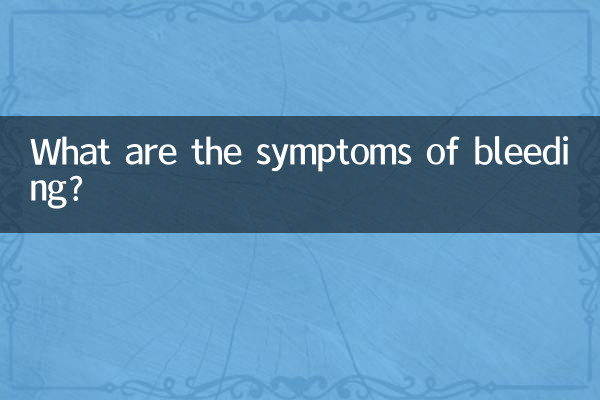What symptoms accompany bleeding? Comprehensive analysis of common manifestations of bleeding
Bleeding is an important sign that something is abnormal in the body and may be caused by trauma, disease, or damage to internal organs. Understanding the symptoms associated with bleeding can help you promptly determine the severity and take corrective measures. The following are the bleeding-related symptoms and professional analysis that have been hotly discussed on the Internet in the past 10 days.
1. Comparison of typical symptoms of bleeding from different parts of the body

| Bleeding site | Typical symptoms | Possible reasons |
|---|---|---|
| Nasal bleeding | Unilateral/bilateral bleeding, bloody smell, foreign body sensation in the throat | High blood pressure, dryness, trauma |
| gastrointestinal bleeding | Vomiting blood/melena, abdominal pain, dizziness and fatigue | Ulcers, esophageal varices |
| subcutaneous bleeding | Bruises and purpura do not fade when pressed | Thrombocytopenia, coagulation disorder |
| intracranial hemorrhage | Severe headache, vomiting, disturbance of consciousness | high blood pressure, aneurysm |
| urinary tract bleeding | Hematuria, painful urination, low back pain | Stones, nephritis |
2. Early warning of dangerous bleeding symptoms
Seek medical attention immediately if any of the following symptoms occur:
1.jet bleeding: Indicates arterial damage, which may cause hemorrhagic shock in a short period of time
2.altered consciousness: Drowsiness or coma accompanying bleeding may indicate cerebral hemorrhage
3.clammy skin: Cold limbs and weak pulse are typical manifestations of shock
4.Bleeding that continues for more than 20 minutes: Conventional compression is ineffective to stop bleeding and requires professional treatment
3. Bleeding-related laboratory test indicators
| Check items | normal value | abnormal meaning |
|---|---|---|
| Hemoglobin (Hb) | Male 130-175g/L Female 115-150g/L | <70g/L requires emergency blood transfusion |
| Platelet Count (PLT) | 125-350×10⁹/L | <50×10⁹/L has the risk of spontaneous bleeding |
| Prothrombin time (PT) | 11-14 seconds | Prolonged time suggests coagulopathy |
| D-dimer | <0.5mg/L | Elevated levels indicate active bleeding or blood clots |
4. Bleeding characteristics of special groups of people
1.Bleeding in children: Nose bleeding and traumatic bleeding are common, and we need to be alert to rare blood diseases
2.Bleeding during pregnancy: Vaginal bleeding in early pregnancy may indicate miscarriage, while bleeding in late pregnancy needs to rule out placental problems.
3.Bleeding in the elderly: For people taking anticoagulants, minor trauma can lead to severe bleeding.
4.postoperative bleeding: If bleeding occurs at the surgical site for more than 72 hours, coagulation function needs to be reviewed.
5. Basic principles of first aid for bleeding
1.compression hemostasis: Use clean dressing to directly compress the bleeding point and maintain it for more than 10 minutes
2.Postural management: For bleeding in the limbs, the affected limb should be elevated; for intracranial bleeding, keep the head elevated.
3.Avoid incorrect operations: It is not recommended to use tourniquets (unless professionally trained), and do not pull out or insert foreign objects at will.
4.Supplementary capacity: In case of heavy bleeding, you should drink salty liquids in small amounts and frequently.
6. Top 5 recently searched bleeding-related issues
| Search keywords | Peak search volume in a single day | main focus |
|---|---|---|
| Causes of bleeding gums | 380,000 | Link to leukemia |
| Color identification of blood in stool | 250,000 | Rectal cancer screening indications |
| Excessive menstrual flow standard | 190,000 | Anemia risk assessment |
| Fundus bleeding symptoms | 150,000 | diabetic retinopathy |
| The wound does not heal and bleeds | 120,000 | diabetic foot care |
Note: The above data statistics are from November 1 to 10, 2023. The data sources include Baidu Index, Weibo hot searches and health vertical platforms.
Summary:Symptoms of bleeding vary widely, and mild bleeding may require just observation, but some bleeding can be life-threatening. It is recommended to master basic hemostasis methods and seek professional medical help in time for repeated bleeding, heavy bleeding or other serious symptoms. Routine blood tests and coagulation function tests during regular physical examinations can effectively detect potential bleeding risks.

check the details

check the details